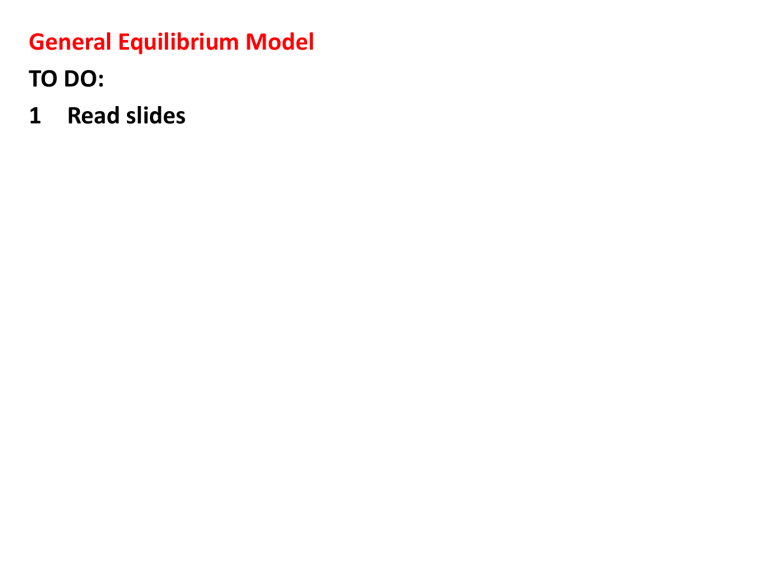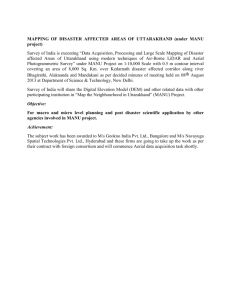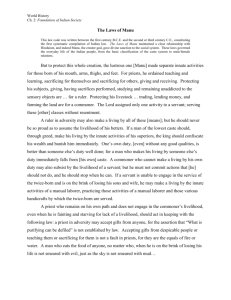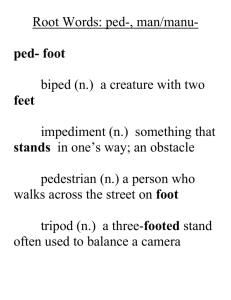
General Equilibrium Model
TO DO:
1 Read slides
Two Countries in Trade
Previous trade theories have emphasized specific sources of comparative advantage
which give rise to international trade:
• Differences in labor productivity (Ricardian model)
• Differences in resources (specific factors model and Heckscher-Ohlin model)
The standard trade model is a general model of trade that admits these models as
special cases
How do determine the direction of trade, the gains from trade, and the role of
government?
“General Model of Trade”
1 Relative demand for goods (Due to relative prices and incomes)
2 Relative supply of goods (Production Possibility frontiers/Technologies)
3 Equilibrium is where relative demand equals relative supply (World Relative
Demand/Supply)
4 Countries differ
– Different preferences will give different Relative Demand curves
– Different technologies will give different Relative Supply curves
– Different factors of production will give different Relative Supply curves
5
6
Hence autarchy prices will differ
This then leads to Gains From Trade
Production Frontiers of Nation 1 and Nation 2
The marginal rate of transformation (MRT) increases
as more units of good X are produced.
The marginal rate of transformation is another name
for opportunity cost.
The value of MRT is given by the slope of the PPF.
Community Indifference Curves for Nation 1 and Nation 2.
The marginal rate of substitution (MRS) falls as more of
good X is consumed.
The MRS of X for Y in consumption is the amount of
Y that a nation could give up for one extra unit of X
and still remain on the same indifference curve.
Equilibrium in Isolation
Interaction of forces of demand (community
indifference curves) and supply (production
possibilities frontier) determine equilibrium for a
nation in the absence of trade (autarky).
Nations seek the highest possible indifference
curve, given its production constraint.
Equilibrium in Isolation Autarchy.
Equilibrium in Isolation
• The equilibrium-relative commodity price in
isolation = slope of tangency between PPF and
indifference curve at autarky point of production and
consumption.
• Relative prices are different in Nation 1 and Nation 2
because of different shape and location of PPF’s and
indifference curves.
Basis for and Gains from Trade with Increasing Costs
• Relative commodity price differentials between two
nations reflect comparative advantages, and form
basis for mutually beneficial trade.
• Each nation should specialize in the commodity they
can produce at the lowest relative price.
• Specialization will continue until relative prices
equalize between nations.
The Gains from Trade
FIGURE 3-6 Trade Based on Differences in Tastes even if
technology is same (Same PPF)
Case Study: Balassa’s Revealed Comparative
Advantage (RCA) Index
• A value of less than unity implies that the country has a
revealed comparative disadvantage in the product. Similarly,
if the index exceeds unity, the country is said to have a
revealed comparative advantage in the product.
RELATIVE DEMAND for goods (RD) or Relative Consumption of Goods X and Y
Cx/Cy
The consumer’s problem is to maximize utility subject to a budget constraint.
– MAX xy {U(x,y)} subject to PxX + PyY = INCOME
– Solution yields demand curves for good x and y
– Demand curve for x are the optimal x’s at different Px’s
• Demand for good x is a function of prices and income (Px, Py, INC)
• If all prices rise by 10% and income rises by 10% then there is no
impact on demands for x or y. (i.e inflation is irrelevant)
• If Px rises with income constant, quantity demanded for good x falls
and quantity demanded for good y rises.
• But, if both Px and Py rise, but income does not, then quantity
demanded for both falls. Under ‘regular’ conditions, they would
fall by the same proportion (eg 10%)
– Hence the only thing that really matters is the relative price (Px/Py).
• A rise in relative price (Px/Py) lowers Cx and raises Cy.
• So (Cx/Cy) falls.
RELATIVE DEMAND for goods (RD): Cx/Cy
• A rise in relative price (Px/Py) lowers Cx and raises Cy.
• So (Cx/Cy) falls.
RD
Px/Py
A
B
Cx/Cy
Qx/Qy
RELATIVE SUPPLY of goods (RS): Qx/Qy
The firms’ problem is to maximize profit in their respective industry.
– MAX Lx PxQx – wLx
– Solution yields supply for good x
– Supply curves are optimal Qx’s at different Px’s
• Supply for good x is a function of prices and technology
• A rise in productivity (say due to more capital) raises supply at any
price (shifts supply curve to the right)
– With free entry, a rise in Px will shift resources into Sector X and out of
Sector Y
– If Px and Py both rise by the same amount, there is no change in
output.
• Hence, changes in relative price (Px/Py) affect supply
– A rise in (Px/Py) will raise Qx and lower Qy.
– Hence (Qx/Qy) rises
RELATIVE SUPPLY for goods (RS): Qx/Qy
• A rise in relative price (Px/Py) raises Qx and lowers Qy.
• So (Qx/Qy) falls.
RS
B
Px/Py
A
Qx/Qy
Equilibrium in Autarchy:
1 Equilibrium occurs where quantity demanded equals quantity supplied in
each sector
2 Relative supply captures the relevant supply side factors and relative
demand captures the relevant demand side factors
3 The equilibrium relative price (Px/Py) ensures that both markets ‘clear’
4 Eg: if one market was not clearing then prices would change
RD
RS
Equilibrium
Px/Py
Qx/Qy
Qx/Qy
Equilibrium in AUT:
1 If there is a rise in Relative Supply, then the Relative Price falls
2 EG; if we produce more MANU and/or less AG, the only way we can sell all
the MANU is if the price of MANU falls relative to AG
3 Alternately: a country with relatively more MANU will have lower relative
prices for MANU
Px/Py
RD
RS
A
B
Qx/Qy
Comparison of Autarchy Prices:
Suppose Home and Foreign have identical endowments and technology but
Home ‘prefers’ to have more MANU than AG
1. They will have identical RS curves by assumption
2. Homes RD curve will be to the right of Foreign’s since their demands are
biased towards MANU
3. This implies, in Autarchy, Home will have higher relative prices for MANU
and consume relatively more MANU
RDHOME
RDFOREIGN
AUTHOME
(Px/Py)HOME
(Px/Py)FOR
RSHOME ; RSFOREIGN
AUTFOR
Qx/Qy
Comparison of Autarchy Prices:
Suppose Home and Foreign have identical preferences but HOME has better
technology in MANU than foreign (and identical endowments)
1. They will have identical RD curves
2. Homes RS curve will be to the right of foreign’s since they have better
technology biased towards MANU
3. This implies, in Autarchy, Home will have lower relative prices for MANU
and consume relatively more MANU
RDHOME ; RDFOREIGN
RSFOREIGN
RSHOME
(Px/Py)FOR
(Px/Py)HOME
AUTFOR
AUTHOME
Qx/Qy
Comparison of Autarchy Prices:
Suppose Home and Foreign have identical preferences but HOME has more capital
than foreign (but otherwise same endowments of L and T and same technology)
1. They will have identical RD curves
2. Homes RS curve will be to the right of foreign’s since they have more K which
is used only in MANU
3. This implies, in Autarchy, Home will have lower relative prices for MANU and
consume relatively more MANU
RDHOME ; RDFOREIGN
RSFOREIGN
RSHOME
(Px/Py)FOR
(Px/Py)HOME
AUTFOR
AUTHOME
Qx/Qy
DIRECTION of TRADE :
1. The country with the lower relative autarchy price for MANU will export
MANU and import AG.
– If home’s relative demand is biased towards MANU, they will tend to have higher
relative MANU prices and so import MANU and export AG
– If home’s relative supply is biased towards MANU, they will tend to have lower
relative MANU prices and so export MANU and import AG. This would arise is they
have,
• better MANU technology,
• more capital,
• less land
GAINS FROM TRADE
• Recall, the gains from trade arise because FT prices differ from autarchy prices
• The bigger the difference, the bigger the gains from trade
• Countries gain on the export side and on the import side.
• This is captured in the Terms of Trade: PEXPORT/PIMPORT
So, how do we find world prices?
WORLD RELATIVE DEMAND for goods (RDW):
1 Each country has a downward sloping Relative Demand Curve for goods
2 Hence, the World Relative Demand Curve will also be downward sloping
3 If countries’ demands are identical, the world relative demand will be
identical the individual relative demand curves
4 If countries’ demands are different, the world relative demand will be
‘between’ the individual relative demand curves. Eg an average
5 The location of the RDW depends on relative sizes of the economies
RDHOME
RDWORLD
RDFOR
Px/Py
Qx/Qy
WORLD RELATIVE SUPPLY for goods (RSW):
1 Each country has a upward sloping Relative Supply Curve for goods
2 Hence, the World Relative Supply Curve will also be upward sloping
3 If countries’ demands are identical, the world relative supply will be
identical to the individual relative demand curves
4 If countries’ supplies are different, the world relative supply will be
‘between’ the individual relative supply curves. An average.
5 The location of the RSW depends on relative sizes of the economies
RSFOR
RSWORLD
RSHOME
Px/Py
Qx/Qy
WORLD equilibrium:
1 Equilibrium occurs where world quantity demand equals world quantity
supplied in each sector
2 The World RS and RD captures all relevant information
3 Given the world relative prices, we can find relative world output.
4 We can also see how the direction of trade with HOME and FOREIGN
relative consumption and demand.
RDWORLD
RSWORLD
Px/Py
Qx/Qy
International Trade with Two Countries:
Case 1: Home has more capital than Foreign, same land and same labour amounts. Same
preferences
• Home has lower autarchy price so exports MANU, imports AG
• Home’s price rises to world, Foreign falls
• Both consume identical relative amounts: Home consumption of MANU falls while AG
rises; opposite for Foreign;
• Home increase production of MANU and reduces it for AG: converse for FOREIGN.
• Both gain
RDHOME ; RDFOREIGN
RSW
RSFOREIGN
RSHOME
FTFOR
(Px/Py)W
FTHOME
Qx/Qy
International Trade with Two Countries:
Case 2: Home has better technology in MANU, same capital, land, and labour amounts.
Same preferences
• Home’s autarchy price is lower than foreign so is the exporter of MANU and importer of
AG
• Home’s price rises to world, Foreign falls
• Both consume identical relative amounts: Home consumption of MANU falls while AG
rises; opposite for Foreign;
• Home increase production of MANU and reduces it for AG: converse for FOREIGN.
• Both gain
RDHOME ; RDFOREIGN
RSW
RSFOREIGN
RSHOME
FTFOR
(Px/Py)W
FTHOME
Qx/Qy
International Trade with Two Countries:
Case 3: Home has same technology, same capital, land, and labour amounts. But Home
has demand biased towards MANU
• Home’s autarchy price is higher than foreign so is the importer of MANU and exporter of
AG
• Home’s price falls to world, Foreign rises
• Both produce identical relative amounts: Home produces less MANU while AG rises;
opposite for Foreign;
• Home increase consumption of MANU and reduces it for AG: converse for FOREIGN.
• Both gain from trade
RDW
RSW
RDFOREIGN
FTFOR
(Px/Py)W
FTHOME
RDHOME
Qx/Qy
INTERNATIONAL TRADE
1 If countries differ in terms of their underlying endowments of
K and T then they will differ in outputs and hence prices.
–
–
–
–
For a given set of prices we can find Qm/Qa
Alternately, for a given Qm/Qa there is a set of prices Pm/Pa that ‘support’ it
If a country has a higher Qm/Qa ratio then it will have a lower Pm/Pa
Hence a high Qm/Qa implies a low Pm/Pa
2 When we move to Free Trade, domestic prices will converge
•
•
High Pm/Pa will fall and the low Pm/Pa will rise (convergence in prices)
But outputs can diverge (each country specializes)
3 This implies some will gain and some will lose
– Terms of trade effects will raise aggregate welfare
– Real returns to Capital and Land owners can diverge (or converge)
– Real returns to mobile factor can rise or fall but likely not much
4 Overall GDP will rise so trade is still a Potential Pareto
Improvement.
POLICY Responses
Suppose we are in CASE 1 where Home exports MANU
and imports AG
1 Can home manipulate the terms of trade with an
import tariff on AG?
2 Can home manipulate the terms of trade with an
export tariff on AG?
3 Does it matter? (Lerner Symmetry?)
Impact of an Import Tariff: Assume Home imports AG
1
2
3
4
An import tariff on AG, for any world prices, will increase the relative price of AG in
the domestic economy.
Consumers respond by shifting into MANU and away from AG. That is, for any given
world prices, the RD curve shifts right. (or shifts vertically upward)
Firms simultaneously respond by shifting into AG and away from MANU. That is, for
any given world prices, the RS curve shifts left. (shifts vertically upward)
Implies, at the given world price, imports fall: consume less AG and produce more
AG. Home becomes more self-sufficient. But exports of MANU falls too.
RD
RS
Px/Py
World price
Cx/Cy
Qx/Qy
Qx/Qy
1.
2.
3.
4
Home’s RD curve shifts right (up) and their RS shifts left (up)
– If Home is ‘big’, then the world RS shifts right (up) and world RS shifts left
(up).
– Hence the world price for AG falls relative to MANU (eg PM/PA rises)
This is a Terms Of Trade Improvement for Home
Aggregate welfare in HOME can rise
– but recall that there are ‘distortions’ induced by the import tariff.
– If the ToT improvement is small, then Home is worse off.
– Nonetheless, since Pa rises,
• Land owners are strictly better off,
• capital owners strictly worse off, and
• labour welfare may or may not rise
Aggregate welfare in FOREIGN falls
– They have a Terms Of Trade Deterioration. Eg export price is falling.
This is the same result as we got from the partial equilibrium
framework: gains depend on the size of the ToT improvement and on
the size of the distortions.
IMPORT TARIFF
• Home is importer of AG and exporter of MANU
• The import tariff shifts relative demand to up and relative supply up.
• World relative demand and supply shift up
• World price rises
RDHOME ; RDFOREIGN
RSW
RSFOREIGN
RSHOME
(Px/Py)W
Qx/Qy
Income distribution effects
5. For Home, the rise in the relative price of AG improves real
incomes for factors used specifically in AG and reduces it for factors
specifically used in MANU.
– Note: the movement from AUT to FT reduced relative AG prices so caused
harm to AG’s specific factor.
– The import tariff reverses the damage but only somewhat.
– Alternatively: moving from AUT to the Tariff softens the blow somewhat.
The winners still win but by less and the losers lose less.
– Can see why governments may want to transition to FT slowly.
6. The converse occurs in Foreign as, for them, the relative price of
AG falls.
– But again, still better than AUT and so will accept a slower reduction in tariffs.
7. Hence there are political winners and losers when we engage in
trade distorting policies.
Impact of an EXPORT Tariff: Assume Home imports AG
1
2
3
4
An export tariff on MANU, for any world prices, will lower the relative price of MANU in
the domestic economy.
Consumers respond by shifting into MANU and away from AG. That is, for any given world
prices, the RD curve shifts right. (shifts vertically upward)
Firms simultaneously respond by shifting into AG and away from MANU. That is, for any
given world prices, the RS curve shifts left. (shifts vertically upward)
Implies, at the given world price, exports fall: consume more MANU and produce less
MANU. Home becomes less reliant on exported MANU. Note that AG imports fall too.
RD
RS
Px/Py
World price
Cx/Cy
Qx/Qy
Qx/Qy
Impact on World Prices and Welfare:
Notice, the export tariff of MANU has the same impacts as the import tariff on
AG. Hence has the same welfare effects.
This is called ‘Lerner Symmetry’: an import tariff is equivalent to an export tariff
INSIGHT: any policies that make it harder to import will, in effect, make it harder
to export since the impact of either tariff on relative prices shifts the importing
economy towards the importable goods. We become more self-sufficient.
Most government focus their efforts on raising exports.
– This means that they will also raise imports as well.
– Attempts to restrict imports will also then hurt exports.
– Import protection is direct and so is perceived to benefit the protected
firms
– Export sectors are hurt but this is an indirect effect so harder to pinpoint
as caused by the import protection (no smoking gun)
– Politically, protection is easier to sell
– Import tariffs will not alter the trade balance since both imports and
exports fall.
Economic Growth
What is the impact of technological growth on national income?
How does growth in other countries affect our economy?
Examples:
• Canadian trade agreements foster greater investment and FDI inflows.
• India and Bangladesh are investing in education at all levels, including
post-secondary. Also in health care.
• China is loaning funds for infrastructure improvements (ports, roads, etc)
in countries around the world (One Belt – One Road initiative).
• China is trying to improve its IT and high tech sectors by investing in AI
diversifying away from low-value manufacturing
RESULT: we know that a rise in our productivity raises our GDP and so can
raise welfare. But does foreign productivity also benefit us?
IMMIZERIZING GROWTH: growth in our export sector will induce a fall in
export prices. It is possible, though improbable, that the fall in prices
dominate the rise in productivity which implies a fall in export revenue. This
is a genuine concern for resource-based economies
CASE I: Unbiased economic growth:
Foreign’s productivity in both sectors rise by the same amount. Eg a rise in
overall education improves productivity in all sectors.
Impact:
• World RS shifts towards foreign
– Foreign RS unchanged since both sectors grow at the same rate
– But size of Foreign gets bigger
• World price falls for Foreign’s export sector
• EG: Home gets a Terms of Trade improvement and gets a net benefit
IMPLICATION: improvements in foreign productivity raise home welfare.
It also raises foreign welfare (their productivity gain is partially offset by their
terms of trade deterioration)
CASE II: Biased economic growth:
Foreign’s productivity in its export sectors rise. Eg foreign gets better at
producing TV’s and computers which HOME imports.
Impact:
• Foreign RS shifts towards its exportable sector (MANU)
• World RS shifts towards foreign’s exportable MANU
– Foreign gets somewhat bigger
• World price of MANU falls which is home’s import sector
• EG: Home gets a Terms of Trade improvement and gets a net benefit
IMPLICATION: improvements in foreign productivity raise home welfare.
It also raises foreign welfare (their productivity gain is partially offset by their
terms of trade deterioration)
CASE III: Biased economic growth:
Foreign’s productivity in its import sectors rise. EG Foreign imports AG and
gets a boost to AG production from GMO innovation.
Impact:
• Foreign RS shifts towards its importable sector AG
• World RS shifts towards foreign’s importable AG
– Foreign gets somewhat bigger
• World price falls of AG falls. This is home’s export sector
• EG: Home gets a Terms of Trade deterioration and gets a net reduction in
welfare
IMPLICATION: improvements in foreign productivity lowers home welfare.
It also raises foreign welfare (their productivity gain is reinforced offset by
their terms of trade improvement)
• Read these too
• https://studylib.net/doc/8070891/relativesupply-and-relative-demand-the-terms-oftrade-an...





